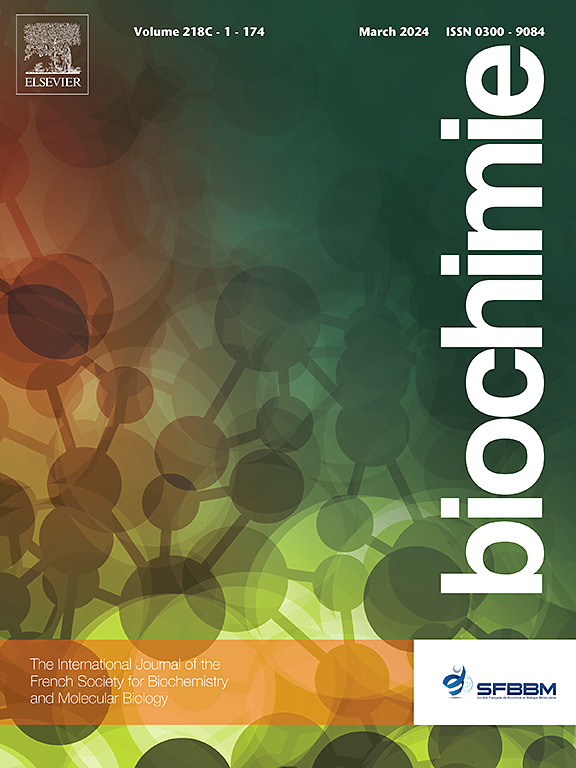森林疫病病毒非结构蛋白NS1在溶液中形成多聚体,具有明显可识别的四聚体状态
IF 3
3区 生物学
Q2 BIOCHEMISTRY & MOLECULAR BIOLOGY
引用次数: 0
摘要
Kyasanur森林病病毒(KFDV)是一种黄病毒,主要存在于印度南部的热带地区,是灵长类动物和非灵长类动物病毒性出血性疾病的罪魁祸首。KFDV感染通过蜱叮咬传播。黄病毒科其他具有重要医学意义的病毒有登革热病毒(DENV)、寨卡病毒(ZIKV)、西尼罗河病毒(WNV)和日本脑炎病毒(JEV)。黄病毒共同导致多种疾病病理,并造成重大的全球健康负担。非结构蛋白1 (NS1)的分泌形式是导致黄病毒发病的一个重要因素。然而,使用致命黄病毒攻击的体内研究已经证明了ns1特异性抗体的保护作用,并补充了探索基于ns1的疫苗和候选治疗方法的可能性的假设。最近对DENV、ZIKV、JEV和WNV NS1抗原的结构研究表明,sNS1蛋白以高阶寡聚态存在。然而,关于蜱传黄病毒sNS1高阶寡聚态的结构见解及其生物学意义尚不清楚。在本研究中,我们在哺乳动物表达系统中表达并纯化了KFDV NS1蛋白。通过尺寸排除色谱(SEC)和负染色透射电镜(NS-TEM)检测,KFDV sNS1蛋白在溶液中表现出更高的低聚构象。KFDV NS1的单粒子分析揭示了四聚体结构与先前报道的其他黄病毒NS1结构相似。本研究为今后合理设计抗蜱传黄病毒的广谱抗ns1抗体和亚单位疫苗提供了思路。本文章由计算机程序翻译,如有差异,请以英文原文为准。
Kyasanur Forest disease virus non-structural protein NS1 forms multimers in solution, with a distinctly identifiable tetrameric state
Kyasanur Forest Disease Virus (KFDV), a flavivirus, is predominantly present in the tropical region of southern India and is responsible for viral hemorrhagic disease in primates and non-primate animals. KFDV infection is spread by tick bites. The other medically important viruses of Flaviviridae family are dengue (DENV), Zika (ZIKV), West Nile virus (WNV) and Japanese encephalitis virus (JEV). The flaviviruses are collectively responsible for diverse disease pathologies and account for a major global health burden. A major contributing factor to disease pathogenesis of flavivirus is the secreted form of non-structural protein 1 (NS1). However, in vivo studies using lethal flavivirus challenge have demonstrated the protective role of NS1-specific antibodies and complement the hypothesis to explore possibilities of NS1-based vaccine and therapeutic candidates. Recent structural studies on DENV, ZIKV, JEV and WNV NS1 antigen have shown that the sNS1 protein exists in high-order oligomeric states. However, structural insights about the high-order oligomeric states of sNS1 of tick-borne flaviviruses and their biological significance are poorly explored. In this study, we have expressed and purified the KFDV NS1 protein in the mammalian expression system. The KFDV sNS1 protein exhibits higher oligomeric conformation in solution as determined by size exclusion chromatography (SEC), and negative stain transmission electron microscopy (NS-TEM). Single-particle analysis of KFDV NS1 reveals tetrameric arrangements that are structurally similar to previously reported NS1 structures from other flaviviruses. Our study will help to develop a future roadmap of the rational design of broad-spectrum anti-NS1 antibodies and subunit vaccines effective against tick-borne flaviviruses.
求助全文
通过发布文献求助,成功后即可免费获取论文全文。
去求助
来源期刊

Biochimie
生物-生化与分子生物学
CiteScore
7.20
自引率
2.60%
发文量
219
审稿时长
40 days
期刊介绍:
Biochimie publishes original research articles, short communications, review articles, graphical reviews, mini-reviews, and hypotheses in the broad areas of biology, including biochemistry, enzymology, molecular and cell biology, metabolic regulation, genetics, immunology, microbiology, structural biology, genomics, proteomics, and molecular mechanisms of disease. Biochimie publishes exclusively in English.
Articles are subject to peer review, and must satisfy the requirements of originality, high scientific integrity and general interest to a broad range of readers. Submissions that are judged to be of sound scientific and technical quality but do not fully satisfy the requirements for publication in Biochimie may benefit from a transfer service to a more suitable journal within the same subject area.
 求助内容:
求助内容: 应助结果提醒方式:
应助结果提醒方式:


